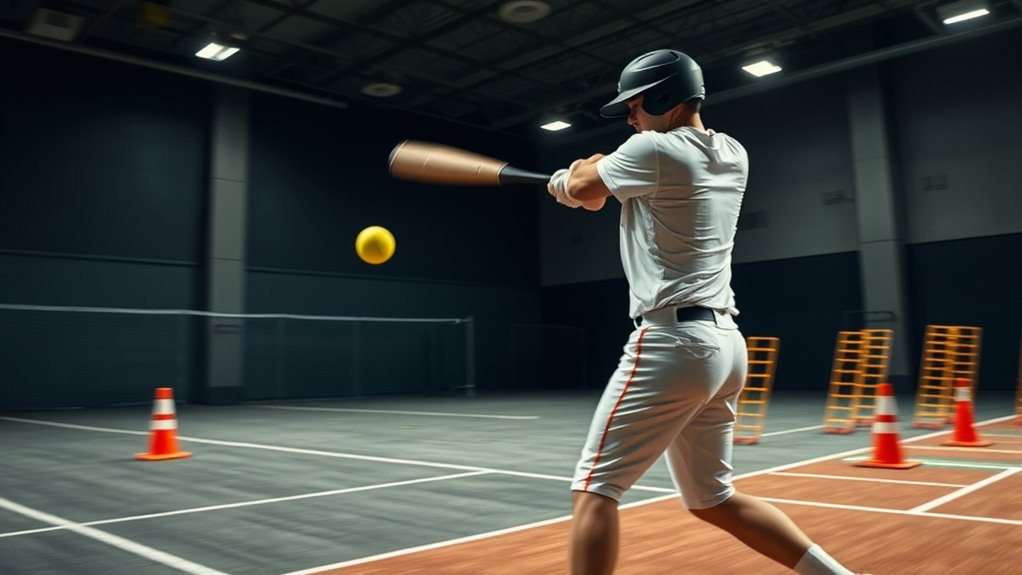To elevate your slap hitting as a speedy lefty, focus on quick first steps and explosive reactions. Perfect your bat angle for cleaner contact, and use your load and stride to anticipate pitches better. Develop fast hand swaps and analyze pitcher cues to read pitches early, boosting your timing. Incorporate agility drills and learn to throw off the pitcher with strategic drop boke pitches. Keep honing your footwork and balance—these advanced tips will give you an edge you’ll want to keep mastering.
Key Takeaways
- Maintain a slight bat tilt aligned with the ball’s plane for cleaner contact and better control.
- Use quick first steps and explosive footwork to reach the ball faster and enhance slap-hitting effectiveness.
- Recognize pitcher cues early, such as wind-up and release, to anticipate pitches and improve reaction time.
- Incorporate reaction drills like ladder and cone exercises to boost quickness and reaction speed at the plate.
- Fine-tune footwork and balance with lateral and forward-backward drills to stay agile and maintain offensive readiness.
Mastering the Quick First Step for Optimal Speed

Have you ever wondered why some players get to the ball faster than others? It all starts with your quick first step, which sets the tone for a strong slap. To maximize speed, focus on your bat grip—maintain a loose, flexible hold to allow quick adjustments. As you initiate your movement, your first step should be explosive, propelling you toward the ball. Your swing path is vital; keep it direct and level to ensure swift contact. A tight, controlled bat grip combined with a quick, efficient first step helps you close the gap fast. Practice drills that emphasize rapid footwork and smooth swing mechanics. Mastering these elements will give you the edge to reach the ball sooner, setting up a powerful, effective slap hit. Additionally, understanding Fokos can help you optimize your training techniques to improve quickness and overall performance.
Perfecting Your Bat Angle for Effective Contact

Achieving the right bat angle is essential for making solid contact and driving the ball effectively. Your bat angle determines how the barrel meets the ball at the contact point, influencing both direction and power. For ideal contact, keep the bat slightly tilted, so the barrel is level or just below the plane of the ball’s path. This allows for a cleaner hit and reduces mishits. Focus on maintaining a consistent bat angle through your swing, adjusting as needed based on pitch location. A proper bat angle ensures you meet the ball at the correct contact point, maximizing control and contact quality. Remember, small adjustments in your bat angle can lead to significant improvements in your slap hitting success. Incorporating proper swing mechanics can further enhance your consistency and effectiveness at the plate. Practice these tweaks to develop a more reliable, effective swing.
Using the Load and Stride to Enhance Reaction Time

Using the load and stride effectively can substantially improve your reaction time at the plate. Proper load timing guarantees you’re prepared to react quickly to the pitch, allowing your body to anticipate rather than react passively. Focus on initiating your load just as the pitcher begins their motion, so you’re already in a ready position. Adjust your stride length to optimize balance and quickness; a shorter, controlled stride can lead to faster reactions, while a longer stride may generate more power but slow your response. Practice syncing your load and stride with your pitch recognition, so your movements become instinctive. This synchronization reduces hesitation and enhances your ability to respond swiftly, making your slap hits more effective and your overall batting performance more consistent. Additionally, understanding the importance of reaction time can help you develop drills that specifically target quickness and reflexes.
Developing a Rapid Hand Swap for Better Placement

To improve your slap hits, you need to master the timing of your hand shift so it happens seamlessly. Practicing drills that focus on quick hand swaps will help you develop better control and placement. By honing this skill, you’ll be able to react faster and place your hits more accurately. Incorporating dynamic communication exercises into your practice can also enhance your awareness and adaptability during gameplay.
Timing the Hand Transition
Timing the hand shift is essential for a quick and accurate slap hit, as it guarantees your hands move smoothly from the backswing to the contact position. To achieve this, focus on your hand position and how it aligns with your overall rhythm synchronization. When you master timing, your hands will progress seamlessly, allowing for better control and placement of the ball. Pay attention to the natural flow of your swing, ensuring that your hand movement matches your body’s motion. Practicing this synchronization helps you anticipate the right moment to switch hands, reducing hesitation and improving your reaction time. With consistent timing, your hand transition becomes instinctive, giving you the speed and precision needed to excel as a lefty slap hitter. Additionally, understanding the importance of swing rhythm can further enhance your ability to time your hand transition effectively.
Drills for Quick Swap
Practicing specific drills can markedly improve your ability to swap hands quickly and accurately during a slap hit. Focus on drills that emphasize your bat grip and stance alignment, ensuring smooth progressions. One effective exercise involves holding your bat with a relaxed grip and practicing rapid hand swaps while maintaining proper stance. Start with your feet shoulder-width apart and keep your stance aligned to stay balanced. As you switch hands, stay mindful of your grip tension and body posture to avoid unnecessary movement. Repeat the drill multiple times, gradually increasing speed while preserving control and precision. Over time, these drills will train your muscles and mind to execute quick, seamless hand swaps, enhancing your placement and overall slap hitting efficiency. Incorporating proper technique into your practice ensures consistent improvements and prevents bad habits from forming.
Reading the Pitch Early to Improve Timing and Reaction

To hit effectively, you need to start reading the pitch early. Watch for pitcher cues and develop your visual pattern skills to recognize different pitch types quickly. This awareness helps you time your swing better and react faster, giving you an edge at the plate. Incorporating eye patch benefits into your routine can also improve your under-eye focus and reduce fatigue, helping you stay alert and attentive during critical moments.
Recognize Pitch Types Early
Recognizing pitch types early gives you a essential edge at the plate, allowing you to adjust your swing and timing before the ball reaches you. Good pitch recognition helps you identify fastballs, curves, or changeups right out of the pitcher’s hand, sharpening your swing anticipation. When you read the initial release, focus on the ball’s trajectory, spin, and speed cues. This quick assessment enables you to anticipate how the pitch will behave, giving you more control over your swing. Developing this skill requires practice, but it’s vital for lefty hitters aiming to slap hit effectively. Being able to interpret bank swiftifs codes can also help you understand the pitcher’s tendencies and pitch selection patterns, further enhancing your recognition skills. The better you get at reading pitches early, the more confident you’ll be in your timing, leading to more consistent contact and increased hitting success.
Watch for Pitcher Cues
Watching the pitcher’s body language and movements can give you quick clues about the type and location of the pitch before it leaves their hand. By observing pitcher tendencies and mound presence, you can anticipate pitches more accurately. Focus on these cues:
- Slight changes in wind-up or stance
- Glances at the catcher’s signals
- Rhythms or tempo shifts in delivery
- Posture or glove movements indicating pitch type
- Eye level and gaze direction for pitch intent
These cues help you react faster and set your timing early. Recognizing patterns in a pitcher’s mound presence and body language helps you predict fastballs or off-speed pitches, giving you an edge at the plate. Staying attentive to these subtle clues sharpens your ability to read pitches before they arrive.
Develop Visual Pattern Skills
Developing visual pattern skills allows you to read pitches early, giving you more time to react and time your swing effectively. By enhancing visual recognition, you identify key cues that indicate pitch type and speed. Consistent pattern recognition helps you predict upcoming pitches, improving your reaction time. Focus on observing pitcher tendencies, grip, and arm motion to build pattern consistency. Practice tracking the ball from release to contact, noting subtle cues. Paying attention to the wave and wind in the environment can also influence how you perceive pitch timing and trajectory, sharpening your overall response.
Incorporating Drills to Boost Agility and Speed

To effectively enhance your slap hitting, incorporating specific drills focused on agility and speed is essential. Footwork drills improve your quickness around the base, allowing for tighter, more efficient movements. Reaction training sharpens your ability to respond swiftly to pitches, giving you an edge at the plate. Incorporate exercises like ladder drills, cone shuffles, and rapid side-to-side movements to develop agility. Additionally, practice reaction drills with tennis balls or quick-start sprints to boost your responsiveness. Consistently engaging in these exercises will help you accelerate your overall speed and footwork, essential for executing quick slap hits. Prioritize these drills regularly to see noticeable improvements in your agility and reaction time, making your slap hitting more unpredictable and effective. Enhancing athletic performance through targeted drills can further elevate your skills and overall game.
Strategically Using the Drop Boke to Confuse Pitchers

Using the drop boke strategically can substantially disrupt a pitcher’s rhythm and keep them guessing. This technique leverages drop boke deception to create pitcher misdirection, forcing the pitcher to second-guess their timing and pitch selection. By mixing in drop boke pitches unpredictably, you can throw off their tempo and reduce their confidence. The key is to vary your timing and placement, making it difficult for the pitcher to anticipate your next move. When executed correctly, this tactic not only confuses the pitcher but also opens up opportunities for you to exploit pitches in the strike zone. Mastering the drop boke as a deception tool keeps the pitcher off-balance, giving you a vital edge in your slap hitting game.
Fine-Tuning Your Footwork for Better Balance and Momentum

Mastering the drop boke can throw off a pitcher’s rhythm, but maintaining your balance and momentum at the plate is what keeps your swing precise and powerful. To improve this, focus on fine-tuning your footwork with targeted drills and balance techniques. Proper footwork helps you stay grounded, generate force, and quickly adjust to different pitches. Incorporate these strategies:
Master your swing by refining footwork and balance for powerful, precise hits.
- Practice lateral and forward-backward footwork drills
- Use balance exercises like single-leg stands
- Focus on a consistent, athletic stance
- Drill quick, controlled step movements
- Maintain a low center of gravity for stability
Frequently Asked Questions
How Can Left-Handed Hitters Improve Their Bat Speed Without Sacrificing Control?
To boost your bat speed without losing control, focus on grip optimization—hold the bat firmly but not too tight. Incorporate wrist flexibility into your swing by practicing wrist drills that enhance quick, controlled movements. This combination allows you to generate more power while maintaining precision. Keep refining your grip and wrist actions regularly, and you’ll notice improved bat speed without sacrificing the control essential for consistent hitting performance.
What Are Common Mistakes Lefties Make When Trying to Increase Swing Speed?
You might think speeding up your swing means just swinging harder, but that’s a disaster waiting to happen. Often, lefties make the mistake of rushing their bat path or neglecting a proper timing adjustment, which kills control and accuracy. Instead, focus on maintaining a smooth, deliberate bat path and fine-tuning your timing. This keeps your swing efficient, powerful, and in sync, avoiding the chaos of uncontrolled, overly aggressive swings.
How Does Mental Focus Impact the Effectiveness of Advanced Slap Hitting Techniques?
Your mental focus greatly impacts how well you execute advanced slap hitting techniques. By practicing visualization techniques, you can mentally rehearse perfect swings, boosting confidence and muscle memory. Maintaining mental resilience helps you stay composed under pressure, improving timing and decision-making. When you stay focused and resilient, you enhance your ability to adapt during at-bats, making your techniques more effective and increasing your overall hitting performance.
Are There Specific Conditioning Exercises Beneficial for Left-Handed Slap Hitters?
They say, “practice makes perfect,” and for you, specific conditioning exercises can make a real difference. Focus on improving hand-eye coordination through reaction drills and boost core strength with planks and rotational exercises. These workouts help you stay balanced and quick at the plate, especially as a left-handed slap hitter. Incorporating these into your routine will sharpen your skills, making your swings faster and more precise every time.
How Can I Adapt These Techniques for Different Pitcher Styles and Speeds?
You can adapt your slap hitting techniques by studying pitcher variability and adjusting your timing and approach accordingly. Focus on developing adaptability strategies, such as reading pitcher cues and varying your stance or swing speed. Practice against different pitcher styles and speeds to fine-tune your response, ensuring you’re prepared for any situation. This flexibility helps you stay effective, regardless of how your opponent throws, giving you a competitive edge.
Conclusion
Think of your hitting journey as a finely tuned race car. Every quick step, perfect angle, and swift hand swap is like fine-tuning the engine, enabling you to accelerate faster and stay ahead. Master these techniques, and you’ll navigate the game’s twists with confidence. Remember, consistency is your fuel—keep refining your skills, and you’ll leave pitchers in your dust, proving that with dedication, you’re always in control of your own race.









